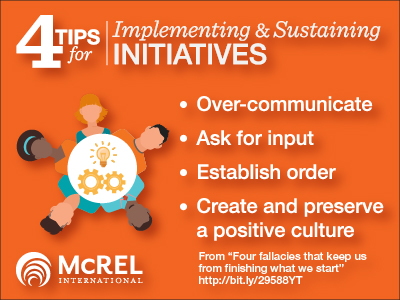
In our never-ending quest to locate the next “shiny object” cure for our challenges, we sometimes overlook an important facet of school and student improvement that is fully within our control: the power to finish what we started.
Why do we so often fail to bring our many important initiatives to fruition? Part of the answer lies in addressing the fallacies that often form our belief system.
Fallacy #1: Believing that when people know what to do they will do it. There’s difference between knowing what to do, and knowing how to do it. Without a step-by-step plan, modeling, guidance, and good descriptive feedback, very few people will take what they have learned and be able to apply it with accuracy, intentionality, and precision in a sustained manner.
Fallacy #2: Believing that fear, facts, and force will overcome people’s resistance to carry an initiative to full implementation. People around the world have known for decades that smoking, excessive drinking, poor diet, and a sedentary life greatly reduces one’s longevity. Yet only one person in 10 makes the lifestyle changes necessary for living longer and maintaining a high level of health. In his book, Drive, Daniel Pink offers a more promising approach: Elaborate on the purpose of implementing the initiative, provide defined autonomy during the process, and assist those implementing until they reach mastery.
Fallacy #3: Believing that doing more will make us better and better. Unfortunately, the opposite has proven to be true. When schools and districts add more work within the school day, the result is that levels of productivity, trust, enthusiasm, and engagement decline. A school-based improvement plan that is built on an overwhelming list of initiatives and their associated activities—and allows little time to implement any one item—is ripe for failure. Taking time to create and maintain a single focus unburdens staff and opens doors for making the initiative “stick” for longer than one academic year.
Fallacy #4: Believing that paying attention to the “what” will bring rapid results without harming the culture. When attention strays from nurturing the culture, everyone suffers. Culture can be described as the personality of an organization, providing the “secret sauce” that keeps an organization healthy and robust. The research base from McREL’s Balanced Leadership® program emphasizes four important leadership responsibilities that require attention when a change, such as implementing an initiative, occurs: communication, input, order, and culture.
Once we accept that these beliefs are false, what else can we do differently to make sure our initiatives are implemented well, and for a sustained period? Here are four important tips:

Ask for input. Allow staff at the school or district level to share their good thinking. Take time to establish a clear message that delineates input from decision-making. Be clear about which person or persons will make the final decision.
Establish order. Providing and maintaining a predictable environment adds stability to the organization, allowing for risk-taking within a safe zone.
Create and preserve a positive culture. Pay close attention to the people and needs within the organization.
Implementation is not an event, but instead is a systems improvement process requiring a well-developed plan that offers assistance along the way, not just a set of marching orders.
Any initiative worth the investment of time and money deserves to cross the finish line.


Dr. Stone,
Agree with your points, especially fallacy # 1, on why projects don’t finish. Administrators assume that implementers know how to roll things out, which more often than not isn’t the case. And it gets worse when the project faces internal resistance.
To add to Daniel Pink’s suggestion (“Elaborate on the purpose of implementing the initiative”), case studies of successful implementation where the target customers have benefitted from the project can be a means to boost the morale of implementers. Many a times, we keep working on things mechanically, not knowing the impact we’re making.
Dr. Stone,
As always, you have provided some good insight with your great thinking! As we continue to work on sustainability, not just the next “shiny object”, in our district, we will continue to look back and reflect on these four fallacies. I believe the real challenge is to develop a systematic culture that can survive a change in staff, especially leadership. Another challenge we face is that we may never really finish what we start. When implementing CITW 2, we will never be finished. We can always improve. That is difficult for some people who want to “arrive” and be finished.
Thanks for your work and insight.
Take Care!